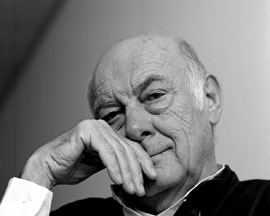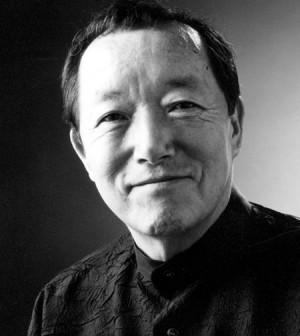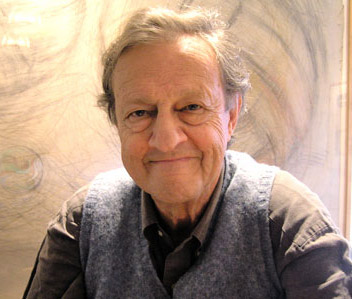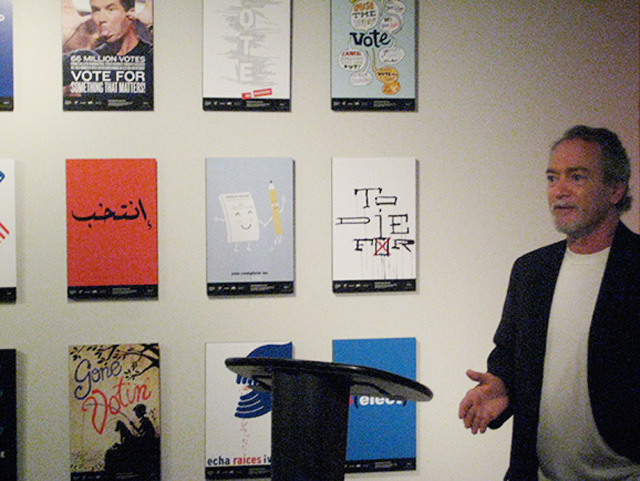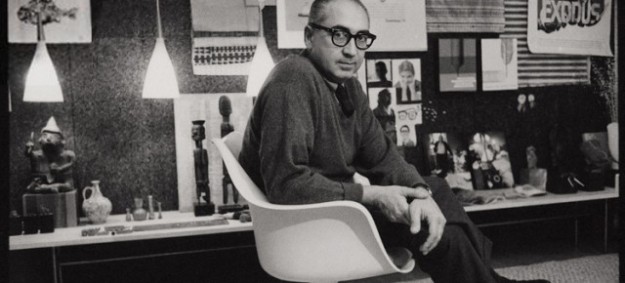Alan Fletcher was one of the most influential graphic design figures in post-war British graphic design. His clever mix of intellectual English tradition with the pop culture of the United States developed his distinctive approach in the late 1950s and 1960s. His obituary in the Daily Telegraph was to call him; ‘…the most highly regarded graphic designer of his generation, and probably one of the most prolific.’
He was born in Kenya to a civil servant on 27th September 1931. However, his father became gravely ill with cancer and the whole family returned to England when Alan was five years of age. He went to live with his grandparents in Shepherd’s Bush before being evacuated in 1939 to Christ’s Hospital in Horsham, an independent school where most of the alumni ended up joining the ranks of middle class England by entering the professions of banking, clergy or the army. However, Alan did not fit easily within these profiles and left as soon as possible to join a college back in London.
Alan Fletcher – Best Graphic Designer
The Art of Looking Sideways
He studied at the Hammersmith College of Arts in 1949 and then later moved to the Central School for Art under Anthony Frostiang and whilst there befriended Colin Forbes, Theo Crosby, Derek Birdsall and Ken Garland of whom were all to be influential in his later career. When he left he had a short period of time in Spain teaching English in Barcelona. After his time in Spain he returned to England to return to study at the Royal College of Arts from 1953-1956 where he met Peter Blade, Joe Tilson, Len Deighton, Denis Bailey, David Gentleman and Dick Smith.
Alan Fletcher married Paolo Biagi in 1956, whilst arguing over the suitability of orange and pink as matching colours. He obtained a scholarship to study at the school of Architecture and Design at Yale under Alvin Eisenman, Norman Ives, Herbert Matter, Bradbury Thompson, Josef Albas, and Paul Rand (after an argument with his college that if Professors were allowed to transfer over to the other college then students should be given the opportunity to do so also. ).
Whilst in the States, he made a point of meeting up with Brownjohn, Chermayeff and Geismar in New York and made friends with Bob Gill. He was then commissioned by Lionni to a cover for Fortune Magazine in 1958. He was quite happy to continue living in New York but his wife was unhappy and wanted to return to Europe so they returned via a visit to Venezuela where they got caught up in a coup after having spent a little time in Los Angeles working for Saul Bass and Pirelli in Milan.
Once Alan Freeman returned to England he founded a design firm Fletcher/Forbes/Gill in 1962 and they wrote a book together called Graphic Design: A Visual Companion (1963). Their clients during this time were Pirelli, Cunard, Penguin Books and Olivetti. Eventually, some members started moving onto fresh pastures and new graphic designers joined and the company renamed itself Pentagram after there were now five partners in 1972 with customers like Lloyds of London and Daimler Benz; the famous Reuters’ logo was produced around this time with the 84 dots creating the word Reuters which was popular from 1965 to 1992. In 1989 the V&A logo for the Victoria and Albert Museum which is still current and the IoD logo for the Institute of Directors is also still in use.
Eventually it was Fletcher’s time to leave the company to go freelance at his home in Notting Hill, assisted by his daughter Raffaella Fletcher and Leah Klein and Sarah Coppleston. He became the art director for Phaidon Press in 1993 and went on to write books about design and visual thinking including ‘The Art of Looking Sideways’ (2001)which demonstrated his wit, elegance and inspiration. Over 1000 pages long of visual thinking which showed his sense of play and broad frame of reference.
His life work was later to be exhibited in a touring exhibition in and outside of England including places like Tokyo. He won many accolades including the Prince Phillip Designer of the Year and became the President of Designers and Art Directors in 1973.
He died of cancer in London on 21st September 2006 leaving behind a wife and daughter.
